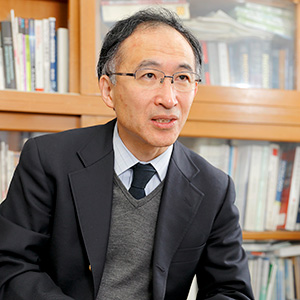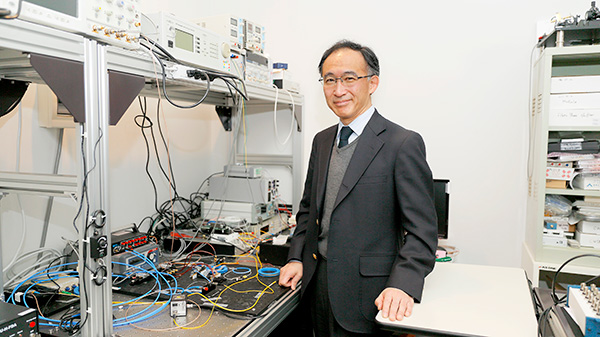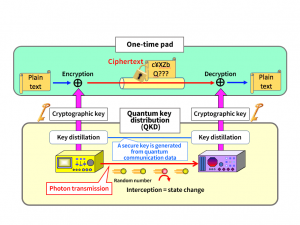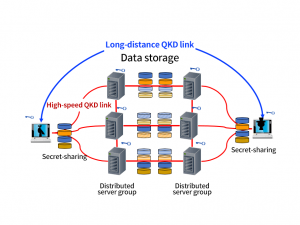- HOME
- Wow! Cool Laboratory [Researcher Introduction]
- Akihisa Tomita
Wow! Cool Laboratory [Researcher Introduction]

Division of Electronics for Informatics,
Research Group of Advanced Electronics,
Laboratory of Optical Processing and Networking
Field of research: physics (atomic/molecular/quantum electronics), applied physics/engineering basics (applied optics/quantum optical engineering), electrical and electronic engineering (communication/network engineering)
Research theme: quantum cryptography, quantum optics, quantum information, optical properties, optical communication
E-mail: tomita[a]ist.hokudai.ac.jp
Research and development toward the realization of a quantum computer using optics and the implementation of a quantum cryptographic network
Quantum key distribution that is unbreakable even after 100 years
The Research Group for Quantum Information Science of the Laboratory of Optical Processing and Networking, led by Professor Akihisa Tomita, has three main research themes: (1) quantum key distribution, (2) quantum computing, and (3) quantum optical imaging. Above all, Professor Tomita leads the field of quantum key distribution (QKD). Quantum key distribution realizes the sharing of an information theoretically secure cryptographic key between two remote parties by encoding a random number sequence (key) to be shared in quantum states (Note 1).
“Intercepting communications can cause the quantum state to change, which allows users to detect the presence of eavesdroppers. Moreover, the magnitude of the measured state change enables the users to estimate the upper limit of the information that the eavesdroppers may obtain. This is the most significant feature of QKD, that is, the upper limit on the amount of tapped information is determined by the increase in the error rate.”
The security of a quantum key is ensured information theoretically. Accordingly, the commutation encrypted by the quantum key will never be deciphered even with future technological advances.
“Electronic charts in hospitals and DNA information of individuals must be kept confidential at least for the lifetime of the individuals—that is, for about 100 years. And if possible, it’s desirable that the safety of their children and further descendants be guaranteed for an ultralong term. Even if a code is currently unbreakable, there’ll be a problem if the encrypted information stored in a datacenter can be broken with future technological advances. Quantum keys would be effective to realize technologies that can keep information secure for an ultralong time not only for data on communication networks but also for stored information. .”
A quantum secure cloud that combines secret-sharing and quantum cryptography
The technology of quantum key distribution has matured to some extent, but some issues remain to be solved before it can be implemented widely in society. For example, (1) the transmission distance and the key generation rate are limited, (2) devices and dedicated lines are costly, and (3) methods for security certification on actual devices are still under development.
To solve these issues, in 2019 Professor Tomita’s research group proposed a quantum cryptographic network that combines secret-sharing and quantum cryptography, which are information storage algorithms (Note 2).
“Secret-sharing technology is already used, but we thought that combining this with quantum key distribution could create a more secure quantum cryptographic network. Although the security of the quantum key itself has already been proven, technological development has yet to progress in terms of how to use it in the real world and what methods are effective when it’s actually used. We want to pursue these as major themes.”
Start of efforts to develop and disseminate quantum ICT
Regarding future developments, Professor Tomita considers two directions. The first thing is to verify the security of the device that performs the optical quantum communication. Regarding this, he intends to develop a practical method with theoretical grounding and link it to international standardization with equipment manufacturers and the National Institute of Information and Communications Technology.
The second is to extend the communication distance. For example, if a datacenter or the like is damaged by a disaster such as an earthquake, it’s very likely that the worst-case scenario can be avoided if the data is distributed to remote locations.
“We aim to secure a communication distance of at least 100 km. If it can be extended to 300 km, it can cover the distance from Tokyo to Sendai or Nagoya. To create a safer social system, I think it’s necessary to extend the distance.”
The professor intends to put more effort into the development of quantum ICT in general, including quantum key distribution. It’s planned that companies, universities, and public research institutes will cooperate in fields such as quantum computing, quantum communication/cryptography and quantum measurement/sensing in order to pursue research while deepening exchanges and collaboration.
“The Quantum ICT Forum was established in May 2019, and activities aimed at the development and spread of quantum ICT in Japan began in earnest in November. Japan is a leader in certain quantum communication fields, so I’d like to pursue research and development with a view to securing the initiative in international standardization.”
 Professor Tomita believes that the realization of simple and low-cost quantum ICT will enable quantum keys to be used on mobile terminals such as drones. |


